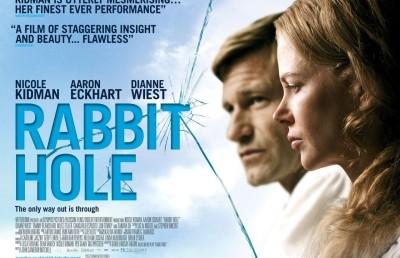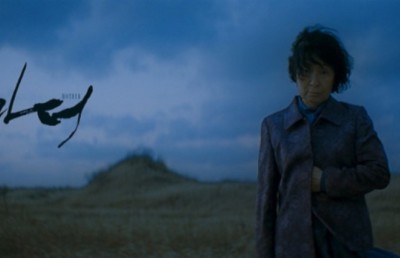Auteurism Ground Zero: The 2010 Cannes Film Festival
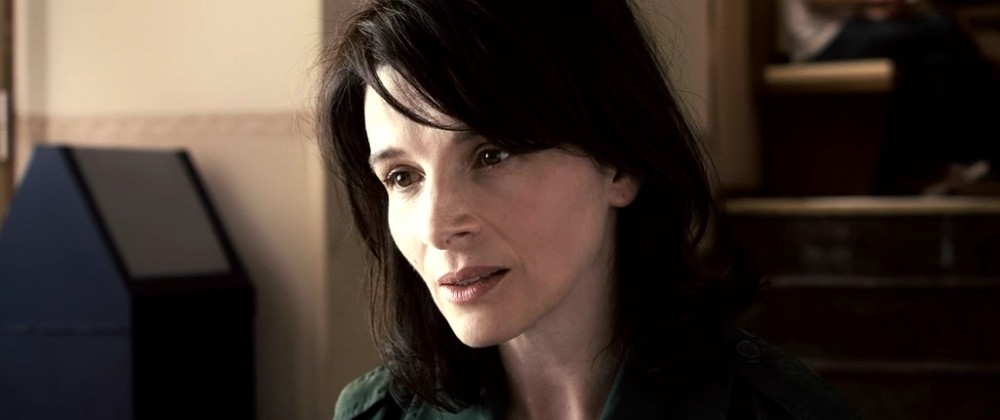
While lesser film festivals, hamstrung by the obscure titles they can snag, must market movies by emphasizing their relation to exotic national traditions, Cannes celebrates its auteurs. A monster banner over the main entrance to the Palais des Festivals trumpets the names of filmmakers featured in the program, and inside omnipresent TV screen broadcast interviews with the anointed few whose productions have been selected for the prestigious showcase, now in its 63rd year. Cannes famed red carpet orchestrates auteur hype by flanking its directors on all sides with photo-ready female stars in glittery attire.
The festival’s eminence grise Gilles Jacob, whose biography has just been published, unrestrainedly endorses the auteur worship that some would label a personality cult. “I would struggle to say if I prefer films to their directors,” he once confessed. And yet, Jacob has a point. As Pierre Bourdieu once observed, in Western culture, “Art is what is created by artists.” To recognize filmmakers as artists—and not just entertainers or producers of mass cultural products—is a central tenet of auteurism. In a long-ago argument between auteurism’s chief American avatar Andrew Sarris and his nemesis Pauline Kael, Kael scoffed at Sarris’s claim that a lesser work by a great director was inherently more interesting than a superior production by a hack. Yet Sarris’s criterion was no different from the standard which has long held sway in the traditional arts. Timon of Athens holds greater interest than A King and No King. Why? Because it’s by Shakespeare.
In film, as in other arts, a work’s style represents the signature of its author. And for auteurists style is identified with directors. At first, auteur critics emphasized directors’ distinctive visual techniques; later this focus was expanded to include soundscapes as well. Where the auteurists departed from standards prevailing in other art forms was to concentrate their attention on a director’s entire body of work rather than a single film. Because movies (especially Hollywood productions) flaunt the marks of a multitude of hands and influences, the auteurists’ focus on a director’s oeuvre allows them to disregard the conventional mode of searching for unity within an individual work. Instead they isolate nuggets within a given film that reveal a distinctive directorial signature (called “moments of beauty” by Eric Rohmer, longtime editor of the journal Cahiers du cinema, where the auteur approach was first introduced in the late 1950s).
To be sure, the 2010 Cannes Festival didn’t achieve the level of auteur star power that has characterized the event in some past years. At the press conference held at the beginning of the event, the fest’s current director Thierry Fremaux confessed, “there were fewer films from established auteurs.” Even so, the 2010 program featured a generous sprinkling of familiar names in the main competition and the “Un Certain Regard” sidebar, including Abbas Kiarostami, Mike Leigh, Ken Loach, and Jia Zhang-ke –not to mention Jean-Luc Godard who, as a member of the original group around Cahiers, was among those responsible for inventing the concept of auteurism to begin with.
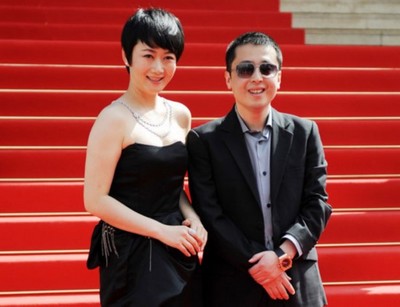
Zhao Tao and Jia Zhang-ke
Its honored place as the world’s most recognizable custodian of the auteur tradition makes the Cannes festival a unique opportunity to revisit this approach, which still guides the thinking of most movie reviewers. Of the films I saw at this year’s fest, Kiarostami’s Certified Copy (Copie Conforme) lends itself most readily to auteurist analysis. Cannes introduced Kiarostami to the international arthouse community by awarding him top prizes in the “Un Certain Regard” and main competitions in 1992 and 1997 (for Life and Nothing More Zendegi va digar hich and A Taste of Cherry Ta’m e guilass respectively). Like these and other films he has made, Certified Copy features Kiarostami’s signature stylistic tropes, most conspicuously a preoccupation with circuitous routes of passage that are mined for metaphoric meaning, a complicated interplay between actor and character, the presence of a director-surrogate, and a sudden shift into self-reflexivity.

Juliette Binoche and Abbas Kiarostami in Tehran, 2007
Certified Copy is Kiarostami’s first European-based film (shot in Tuscany), and his first to feature a world-renowned movie star (Juliette Binoche). [1] As such, this new work represents a radical departure from the director’s earlier productions. Many Kiarostami fans have learned to love the minimalist poetry of his Iranian films, most conspicuously on display in the famed earthquake trilogy where children and other non-actors perform in bare, quotidian narratives set amid parched landscapes and meager villages. When faced with a Kiarostami seemingly caught in the thrall of ravishing scenery and celebrity glamour as we were this year at Cannes, some in the audience were moved to catcalls. But as Peter Wollen once argued, the styles and themes of the greatest auteurs develop over time, and we must wait to see how this change in situation plays out as Kiarostami’s career continues to evolve.
In the meantime, it seems safe to say that Kiarostami has adapted his thematic concerns to fit his altered circumstances. Finding himself filming in the Western world’s most aesthetically revered countryside with a leading lady who has been called the most beautiful woman on earth, the director has sensibly chosen to make a movie about art—and more specifically about the nature of aesthetic appreciation
The film draws on many familiar Kiarostamian tropes. Its story, written by the director himself, concerns a British author (opera star William Shimell) who briefly tours southern Tuscany in the company of a Frenchwoman he has just met (Binoche). The title of the author’s new book echoes the title of film, just as the author can be seen as a version of the film’s director. As the two new acquaintances wend their way through various Tuscan byways, first in a car then on foot, they flirt, quarrel and playfully adopt new personas.
In the course of the couple’s adventures, the status of copies, the significance of originality, and the nature of beauty itself are put under a microscope both by the characters and by the film. After the camera turns its gaze on the spectacle of the summer Tuscan hills, someone comments on the loveliness of the cypress trees. But later someone else asks rhetorically, “who dares to say that a leafless garden isn’t beautiful?” At another moment Binoche looks in the mirror as she adorns herself by adding lipstick and earrings. Is she now better looking than she was before? It depends on the eye of the beholder.
Works of art, too, come in for scrutiny. As Walter Benjamin famously observed, the modern, technology-based art forms of film and photography lack the aura that hovers over unique works of traditional art. These new media exist instead only as copies. Benjamin’s insight is developed at some length in Kiarostami‘s film. During their explorations, Binoche shows Shimell a treasured reproduction of a Roman fresco created by a famed Neapolitan forger, a work that has itself achieved the aura of a rare and valuable object: a copy with its own aura. Even classic pieces of art honored as originals are questioned as someone remarks that these merely represent copies of once-living models (thereby recycling an idea about art first proposed by the Greeks). So perhaps Kiarostami’s work of technological art is not so different from what has come before.
If Kiarostami’s film is just a copy, so are the characters it portrays. In a variation on the explorations into the mise-en-abime of human identity that have characterized his past work the director here exploits the multi-layered persona of his iconic star to good effect. “My one concern was working with Juliette,” he told an interviewer when asked about his approach to the project. “I thought it would be something new and different.”
Kiarostami came to know Binoche years ago—through the Cannes fest—and wrote the Certified Copy with her in mind. In accepting the best actress prize the 2010 festival awarded her for her performance, Binoche confessed that Kiarostami had discouraged her from acting. “It’s you,” he told her when she asked him to describe her character. “Just be yourself.” For Kiarostami the straightforwardness inherent in such an instruction is deceptive, for it raises the question, “who is ‘yourself’?” The familiarity of the Binoche persona inevitably intrudes itself into every role she takes on. In Certified Copy this association is further complicated by her status as the 2010 Cannes poster girl, which meant that her image was plastered all around the Palais during the festival. For Kiarostami such a public presence adds a further layer of complication to the already ambiguous status of the woman Binoche portrays in his film. At a certain point in Certified Copy, Binoche and Shimell “pretend” to be a long-married couple, then abruptly adopt these new personas as their “real” identities. Who are they actually? Binoche’s character is never named but identified in the movie’s credits simply as “she.” Who is “she”? A Frenchwoman who has just met up with a British author? A woman married for fifteen years who fears her husband has lost interest in her? The actress Juliet Binoche? Or a moving picture that represents a copy of Binoche? And who is Binoche? The public face of the famous actress? The private activities of the offscreen woman? One could go on endlessly with such questions. They gain a special edge through their association with Binoche’s star image, but they also develop well-established concerns of the film’s auteur director.
Binoche, for her part, has long networked Cannes to forge working partnerships with auteurs the festival has elevated to prominence, including not just Kiarostami, but Hou Hsiao-hsien and Amos Gitai besides. Next she will star for Jia Zhang-ke, another Cannes favorite who also had a movie in competition this year. Like Kiarostami’s film, Jia’s I Wish I Knew (Hai shang chuan qi) represents both an identifiable addition to the auteur’s oeuvre and an evolution of his thematic concerns. Jia has had two previous films selected for the Cannes slate: Unknown Pleasures (Ren xiao yao) in 2002 and 24 City (Er shi si cheng ji) in 2008. His new production brings the Sixth Generation Chinese filmmaker closer to the purely documentary mode he has been inching towards in his recent work.
Paradoxically, for Jia, as for other Sixth Generation auteurs, the slice-of-life approach they favor, with its emphasis on location shooting, non-actors, and long takes, only brings them closer to the essentially elusive nature of the reality they seek to capture. They cope with this impasse by resorting to various self-reflexive moves that recast their portraits of the world as just that: their portraits. In Jia’s case, the result is a proliferation of multiple points of view as he struggles to approach the unapproachable from as many angles as possible, and a subtle interplay between fictional and documentary modes that signals his awareness of how hopeless his task is.
The title of Jia’s new film, I Wish I Knew, alerts viewers to the impossibility inherent in his project. [2] Conceived as a portrait of Shanghai and its history, I Wish I Knew focuses on interviews with present and former residents of that byzantine metropolis captured in extended shots that invite interviewees to expand on their memories in a leisurely fashion. This tapestry of monologues by now-aging witnesses of Shanghai’s tumultuous ride through the Twentieth Century are interspersed with actuality footage and clips from well-known Shanghai-based films of the past.
Though I Wish I Knew may not meet the high standard set by Jia’s wonderful 2006 production Still Life (Sanxia haoren), its warmth and diversity of perspectives will engage sympathetic viewers. The key to enjoying this new film is to give up the thought of coming away with any kind of definitive history of modern Shanghai—an enterprise which would be doomed to failure in any event given that one is dealing with a vast urban space that has been deeply marked by repeated political upheavals and a bewildering polyglot of cultural styles. Instead, Jia offers a gallery of snapshots taken from the lives of the city’s citizens. All of these reporters carry with them profound emotional baggage with which history has burdened them. Yet all tell their stories with composure and even serenity. In one of the film’s most affecting motifs a number of the people on camera sing popular songs they recall from their youth. Some are Chinese folk melodies, others Western pop ballads. In the midst of the often-horrific tales of carnage and family tragedies these Shanghai survivors have to tell, such poignant lyrical interludes testify to the sustaining veil of pleasure and comfort nostalgia casts over even the most psychically wounding passages in people’s lives.

I Wish I Knew
Even as we become immersed in these personal recollections, however, Jia pulls us back by repeatedly reminding us that even the monologues he so faithfully records are not windows into an unvarnished reality but rather narratives prompted by a particular set of circumstances –specifically, by the presence of the filmmakers. At one point, soft ringing tones interrupt a story being told by one of the interviewees. “Is that someone’s cell phone?” the man hesitantly inquires. At another moment, as Jia’s cinematographer Yu Likwai trains his lens on a group of people playing “Go” in the entrance to a shop, one of the participants looks into the camera and waves her arm invitingly. “Come in and film,” she says.
In a new twist on these Brechtian strategies, Jia further complicates I Wish I Knew by including clips from films set in Shanghai made by others, reminding us that his rendering of this richly evocative place is simply one of many. He also interviews some of the people who participated in creating these alternate views of the city —views which have themselves become part of the matrix through which Shanghai is now seen and understood. The most striking of the moviemaker interviews in I Wish I Knew is with Zhu Qian-sheng, who was the Chinese advisor to Michelangelo Antonioni when the Italian auteur came to film Chung Kuo–cina in Shanghai in 1972. Many years afterwards Zhu was called to account before the Chinese authorities, who had just seen Antonioni’s movie on television and did not approve of how this outsider had depicted their city. In the end Zhu was not severely punished for his role in Antonioni’s production, but he could have been. Movies, it seems, can shape not just our view of history but also history itself.
Early reviews of I Wish I Knew were mixed. Many critics found the film overlong at two-plus hours, and most objected to the presence of actress Zhao Tao, Jia’s muse, who appears at intervals wandering about contemporary Shanghai in yet another of the director’s self-reflexive motifs. If Jia were to take such judgments to heart and revise his film in response—as other Cannes auteurs have done in the past—what would such a development say about the auteur theory? It would, in a sense, give critics the status of collaborators. And collaboration is something the auteur theory—and aesthetic theory in general—stumbles over. Dominant modern accounts of aesthetic appreciation see creative talents as originary geniuses whose unique sensibilities distinguish their output and constitute its value as art. Such a conception works well enough when applied to high art forms which support the image of isolated individuals toiling away in attics. But movies are a famously collaborative medium, which makes for an uneasy fit with this theoretical model.
Most reviewers, whether they subscribe to auteurism or not, are careful to mention the achievements of various individuals who might have contributed to the success of a given film. But in casual parlance, directors get more than their fair share of acclaim. Many movies today –even Hollywood productions– begin with a so-called “possessory credit,” which claims that a film belongs solely to its director. And journals –including this one– routinely follow film titles with the names of their directors, even though in many cases the person most responsible for the final shape of a given production is its writer, producer, or star. The presumption of such auteurist-driven policies is that any film good enough to deserve a write-up will necessarily represent a distinctive directorial signature. But even if one grants this point, such a practice has unlooked-for implications.
Auteurists may argue that criticism aimed at discerning aesthetic value should not concern itself with documenting the contributions of a film’s minor players. But, to be vulgar, there are jobs and fame at stake. Women, in particular, have historically been socialized to act as helpmates rather than stars. Habituated to relinquishing their names and subordinating their identities to men, women are unlikely to squabble over credit, let alone aspire to helm productions on their own. Consider Alma Reveille Hitchcock or Suzanne Shiffmann, two well known examples of self-abnegating women filmmakers. The names of countless others have long been lost to history. The anonymous supporting roles that women like these have played are virtually never taken on by men. Women have been the quintessential collaborators; but the auteur theory leaves no room for collaborators.
The Cannes Festival is symptomatic of this dilemma, for though its juries and red-carpet premieres are loaded up with women actors, its favored directors are virtually all male. The main 2010 competition, for example, included no films directed by women. Even more importantly, the hagiographic atmosphere with which Cannes surrounds its auteurs has the effect of marginalizing everyone else whose creative labor contributed to a movie’s ultimate effect.
The worship of auteurs creates a further problem as well, for directors themselves, emboldened by their elevation to the status of individual creative geniuses, may feel tacitly encouraged to participate in this tunnel vision. Even before the rise of auteurism, directors sometimes claimed authorship for what was not theirs. Joseph McBride’s biography of Frank Capra documents the way in which this venerable Hollywood auteur routinely took credit not only for his own accomplishments but also for those of his writers. And Capra was far from the only director to commit this sin.
I was reminded of this problem during the 2010 Cannes master class with Italian director Marco Bellocchio. Bellocchio has long been a leading figure of world cinema, having created a distinctive oeuvre that began with Fists in the Pocket (I pugni in tasca) in 1965 and has continued through last year’s fest circuit favorite Vincere. Over the years the work of this eminent filmmaker has been represented in the main Cannes competition no less than five times. The master class, conducted by Michel Ciment, editor of the French auteurist journal Positif, began with a review of Bellocchio’s early days as a painter in the mode of Expressionist Egon Shiele. From this high art form, where he was unencumbered by the voices of others, Bellocchio moved into the messier medium of film. This part of the interview raised some provocative ambiguities, especially around the issue of collaboration. In the write-up of the event on the festival‘s website, Bellocchio was quoted as follows. “There is no democracy or equality on the set; there has to be rigor, interest, affection and respect.”
During the master class itself, Bellocchio touched on specific on-set relationships he has experienced. He recalled working with Michel Piccoli on A Leap in the Dark (Salto nel Vuoto) in 1980. Bellocchio began to describe his collaborative process with the French star, then stopped short. “Piccoli is a genius,” he stated summarily, thereby bringing the topic to a close. At another point, however, Bellocchio elaborated on his use of the term “genius” in the course of recalling his collaboration with Ennio Morricone, the composer he worked with on Fists in the Pocket and other early films. “Morricone is a genius,” Bellocchio affirmed. “But then, he produces his own music. When you work with young composers, then they are very available.” At the end of this event I couldn’t help wondering whether Bellocchio thinks of geniuses as collaborators who consider themselves equal to the director and lack appropriate respect for the auteur’s singular vision.
The 2010 festival also was the setting for a more disturbing example of the tendency of auteurs to see collaborators as potential competitors: Alejandro Gonzales Iñàrritu, whose movie Biutiful played as part of the main competition. When the Cannes fest presented Iñàrritu’s last film Babel, in 2006, the movie’s screenwriter Guillermo Arriaga was banned from attending. Iñàrritu was angry because Arriaga had given an interview about the pair’s prior collaboration on the 2003 production 21 Grams, in which, according to Iñàrritu, the writer took more credit than he deserved. The festival bowed to the auteur’s will, and Arriaga was denied a place on the red carpet at Babel??’s Cannes premiere, despite the fact that the Mexican novelist-turned-screenwriter had won the festival‘s screenwriting award the year before for his work on ??The Three Burials of Melquiades Estrada.
Iñàrritu’s new film Biutiful was co-written by Armando Bo and Nicolas Gracobone, two Argentinean neophytes, from a story supplied by the director. At the press conference following the Cannes screening, the first words out of the auteur’s mouth were, “I have always been in complete and total control of my films.” “Alejandro had the story in his head,” one of the young scribes said later on. “Then it was just follow him.” The other screenwriter added, “Alejandro is one of the greatest directors of all time.” The film that emerged from this hierarchical relationship between director and writers was not on a par with the auteur’s previous films Amores Perros (1999), 21 Grams, and Babel, until Biutiful, the only movies he has helmed –and all collaborations with Arriaga. If the evidence of Biutiful is to be believed, Iñàrritu needs the give-and-take inherent in a true collaborative process to reach his greatest potential—whether he wants to acknowledge this fact or not.
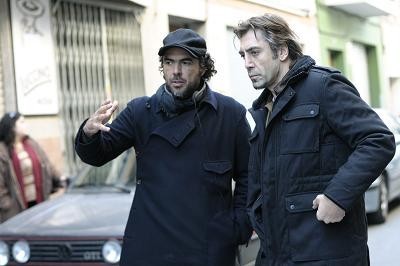
Alejandro Gonzales Inarritu & Javier Bardem on the set of Biutiful
To be sure, Biutiful has its virtues. The story of a small-time criminal’s final days in Barcelona, the production works most effectively as a vehicle for the acting prowess of its star Javier Bardem. Bardem plays Uxbal, the film‘s main character, a man whose steadily mounting travails see him become increasingly pale, gaunt and haggard as the action wears on. A dominating presence in almost every scene of the film, Bardem was a popular choice for acting honors at the festival. The movie’s setting in a lower-class ethnic neighborhood of narrow alleyways and crowded thoroughfares was another high point of Biutiful, lending itself nicely to the kinetic, handheld camerawork at which Iñàrritu and his cinematographer Rodrigo Prieto excel. An episode near the beginning involving a police raid in a jam-packed city square creates an especially noteworthy set-piece.
But, as most reviewers noted, ??Biutiful??’s screenplay is weak. Misfortune after misfortune befall the movie’s hapless hero, many involving his two young children (one of whom misspells “beautiful,” thereby supplying the movie‘s title). Subplots proliferate, some integral to the main story, others simply distracting. Most distracting is the narrative’s ill-conceived foray into the supernatural. Early on we learn that Uxbal can communicate with the dead, a new thematic interest for Iñàrritu and one that does not sit well with the rest of the film.
A forthcoming book on Iñàrritu devotes the bulk of its discussion to the fractured storylines that distinguish Amores Perros, 21 Grams, and Babel. But the book devotes scant attention to the screenwriter who certainly had a hand in devising the challenging, convoluted narratives of these films. Unlike Bellocchio, whose powerfully idiosyncratic style can carry the day even in the face of sketchy storylines and uninspired performances, Iñàrritu, for all his energy and slickness, lacks a distinctive stylistic signature that could salvage films lacking in other areas or become the basis for constructing a coherent oeuvre.
Is auteurism’s focus on solitary genius-creators part and parcel of Capitalism’s elevation of individuals over groups? Radical filmmakers have long accepted this argument, and many have tried to create a tradition of “Third Cinema” founded on principles of collective endeavor. The 2010 Cannes festival’s “Un Certain Regard” section featured an example of such an approach in The Lips (Los Labios), an Argentinian film co-written and co-directed by Santiago Loza and Ivàn Fund. Like I Wish I Knew, The Lips mixes fictional and documentary modes, but it does so in a less self-conscious manner than Jia‘s auteurish exercise. Loza and Fund’s roots lie in neorealist social commentary rather than in postmodernist self awareness, a tradition that goes back at least as far as the canonical 1968 Argentinian documentary The Hour of the Furnaces (La Hora del los hornos). Co-directed by Fernando Solanas and Octavio Getino, The Hour of the Furnaces also featured input by its first audiences which was used to craft the second part of this massive production. Following the ideals of the Third Cinema movement, The Hour of the Furnaces is film of the people, not of the auteur.
Unlike The Hour of the Furnaces, The Lips doesn’t incorporate the ideas of its audience, but it does feature ordinary people. The story –if it could be called that– involves three female public health workers who venture into the impoverished Santa Fe region of northwest Argentina to minister to the needy. Though all three public health workers are represented by actresses (Eva Bianco, Victoria Raposo, and Adela Sanchez, who garnered well-deserved prizes for their work in the film), the families they confront in the course of their ministrations are actual residents of the area. In many cases, the horrendous problems these people describe would be dismissed as over-the-top melodrama were they recounted by actors.

Eva Bianco, Victoria Raspo, & Adela Sanchez in Lips
Following neo-realist precepts, The Lips features no cogent story line. The social workers simply visit one family after another. Each of the three women adapts somewhat differently to the trying conditions they are faced with, but there is no central narrative conflict, and no closure. Maria Laura Collasso’s sensitive hand-held cinematography adds to the movie’s informal ambiance, holding for extended periods on the faces of people who never imagined they would appear on camera.
Unfortunately, a film like The Lips is more admirable than admired: admirable for its political ambitions, but lacking in aesthetic panache. Compared to the complex, tightly-woven formal strategies that distinguish auteur masterworks like Certified Copy or I Wish I knew, Loza and Fund’s movie feels thin and meandering. Perhaps this situation is inevitable. Like it or not, we are trapped within a culture where art is defined as individual expression.
The nature of this dilemma was underlined at the 2010 Cannes festival by Jean-Luc Godard’s entry into the “Un Certain Regard” competition, Socialist Film (Un Film socialisme). Critics have long lionized Godard as the greatest filmmaker of the post-world-war II era. After 1968 the newly radicalized French auteur attempted to escape from this collusion with the Capitalist mindset by burying his identity within a collective enterprise called the Dziga Vertov group, named in honor of the nom-de-plume of the great Soviet filmmaker Denis Kaufman. The few critics who took the trouble to see and comment on the impenetrable political diatribes Godard and his group put out during the 1970s, however, continued to speak of them as works by Godard, the auteur. And indeed, Godard himself, irascible, provoking, and given to colorful, if gnomic pronouncements, is nothing if not a distinctively individual presence. Eventually, the Dziga Vertov group disbanded, and Godard resumed the practice of signing his films with his own name.
The screening of Socialist Film at this year’s Cannes event brought all these contradictions to the fore. As with Godard’s other recent work, this new production is an impressionistic collage of narrative fragments interspersed with political and philosophical statements. Its three-part structure begins with satiric vignettes shot on a cruise ship, shifts to a series of interactions among members of a family who operate a garage in the French countryside, and thence to several brief scenes set in a variety of politically-charged locales, including Egypt, Palestine, Odessa, Naples and Greece. In a new twist on his many innovative Brechtian moves, Godard here parodies the often cryptic and distorted subtitles in foreign language productions by providing even more cryptic and distorted English subtitles for dialogue spoken in French. These “translations” are artfully arranged in patterns and, at times, they gain an almost poetic resonance. Perhaps it does Socialist Film a disservice to call it a film at all; shot on a range of devices including HD video and camera phones, it was slated for a VOD release immediately after its Cannes premiere and streamed in a speeded-up five-minute version just before the festival.

Socialist Film
Godard did not show up for his scheduled Cannes press conference and the credit card at the end of Socialist Film said merely “NO COMMENT” in bold black capital letters. Nonetheless, the empty space vacated by the auteur had to be filled. Though the people on either side of me at the press screening spent their time texting rather than watching and I noticed the lights of innumerable cell phones glowing during the movie‘s entire running time, Socialist Film received uniformly respectful reviews. Back away from it as he will, the Godard name carries great weight.
If Godard has been unable to reconcile the problems inherent in auteurism, perhaps it represents an insoluble conundrum. Is the model of aesthetic meaning which finds its source in the emotional connection audiences make with a single creative sensibility the only possibility? Some theorists have proposed alternate approaches. A few have championed the aesthetic value inherent in the rich array of meanings made available through generic interplay (André Bazin, Jane Gaines). Others have posed the possibility that corporations could be thought of as auteurs (Thomas Schatz, Jerome Christiansen, Bazin again). But neither of these hypotheses has thus far been able to compete with the concept of an individual artist communicating a unique emotional experience, an idea that has held sway in the traditional arts for eons and which still remains the sole means by which we can account for works which rise above cliché and banality. The auteur theory may have its limitations, but at this moment in time, we lack viable alternative explanations of how film can function as art. Given this lacuna the celebration of auteurs that happens each year at Cannes seems an inevitability.
As a festival dedicated to auteurs, Cannes features not just new films but old ones as well; its “Cannes Classics” section screens notable restorations and other vintage fare. But new discoveries are the main event here. I have sometimes wondered why the French have allowed the Italians to seize the cultural high ground to be gained by focusing on the treasures of film history, a project which the magnificent Pordenone and Bologna film festivals have taken up. But, after all, why should they? Let the Italians have cinema’s past. Thanks to Cannes –and its auteurs– the French own its future.
Endnotes
1 Binoche had previously appeared briefly in Kiarostami’s 2008 production Shirin as a member of an all-female audience watching a play in Tehran.
2 If the film is released in North America the title may be changed to Shanghai Legend, a more literal rendering of the original Mandarin. Mandarin speakers I consulted had further glosses on the title. What follows is an edited version of information supplied by Meng Duosi, Xiang Xuehua, Daan Pan, and John Rohsenow. Thanks to all for sharing your expertise.
The title Hai shang chuan qi may be a play on words, as Shanghai is often called a city at the sea (haishang chengshi) and Shanghai culture is haipai wenhua. The deeper background may come from the expression: ‘haishang hua’: (Literally: Shanghai Flowers). There was a Chinese novel written at the end of Qing Dynasty called haishang hua Chuanqi. (Romances/Tales of the ‘Flowers’ of Shanghai). It’s a book about the lives of the prostitutes in Shanghai and is the first dialect novel in China. Eileen Zhang translated it into Mandarin and then into English in 1975. In English it’s called The Sing-Song Girls of Shanghai. That is why, for example, the movie Flowers of Shanghai was called in Chinese: Haishanghua, not Shanghai Hua. (From the linguistic point of view, this may be related to the way of using prepositions in ancient Chinese.) There is also a TV-drama called “Haishang Chuanqi,” about ordinary people’s lives in modern Shanghai.
The movie’s title cards reproduce calligraphic figures originally rendered by Chairman Mao.



